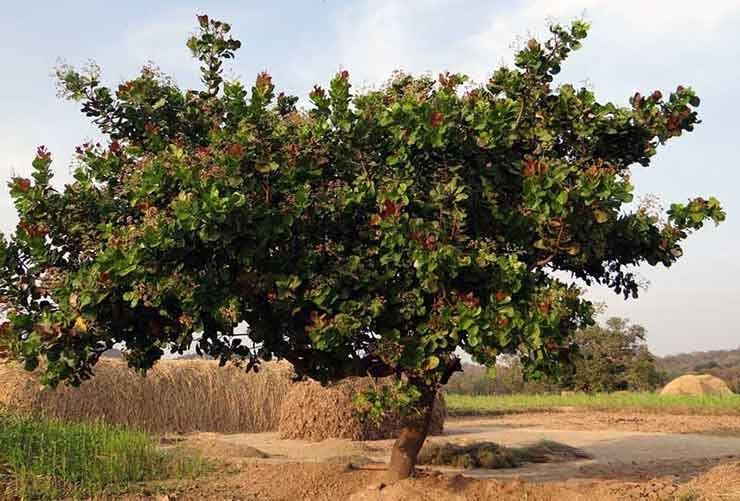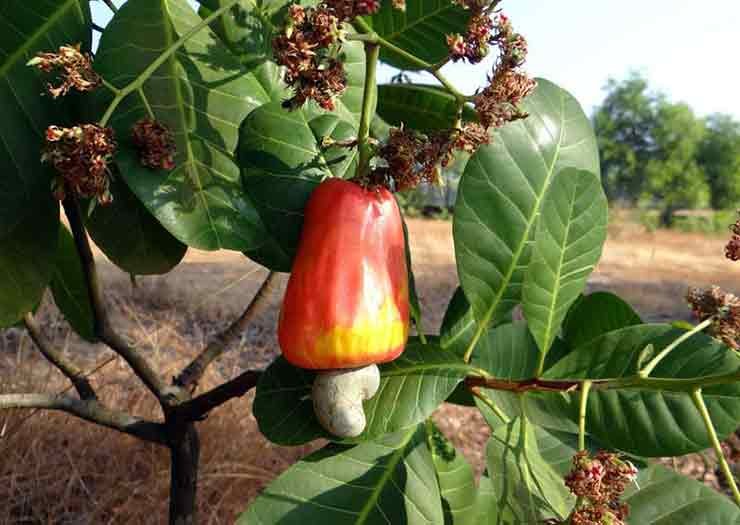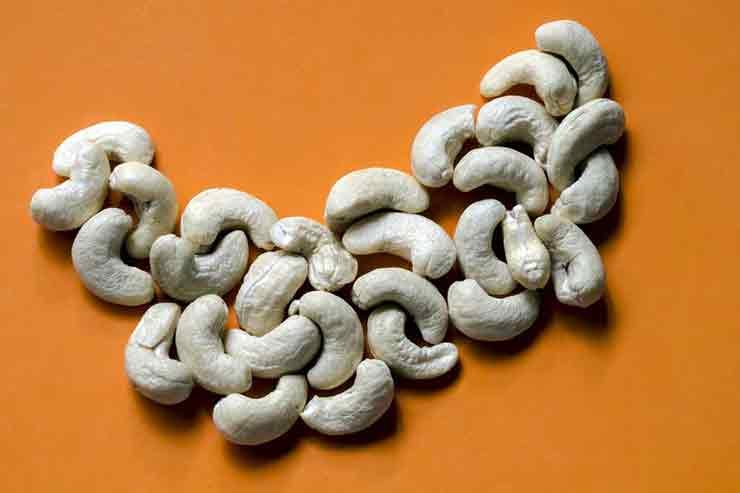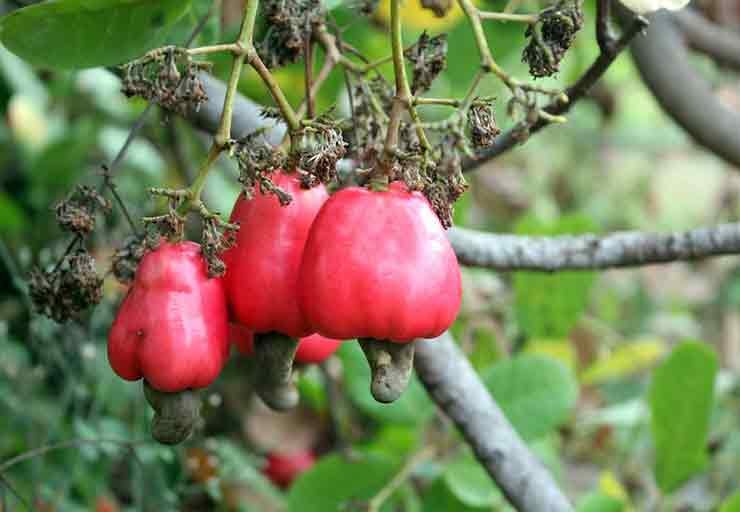- Get link
- X
- Other Apps
Cashew Plantation in India: Guide to Cashew Nut Cultivation
Cashew plantation in India is a very profitable agrobusiness. Here is the complete guidance on cashew nut cultivation from seed selection to cultivation to pest control of cashew plants and harvesting.
The tropical evergreen plant cashew (Anacardium occidentale), also known as Kaju plant or Kaju badam tree usually develops as high as 46 ft, while dwarf cashew grows up to 20 ft. With an earlier maturity, higher yield, and increasing demand in the market, cashew has been one of the most preferred choices of farming to cultivators. Being native of Central American and South East Central Brazil, it was first cultivated in the Malabar Coast of India. With high potential to earn foreign exchange, Indian cultivators started growing it commercially since 1920.
Varieties of Cashew Plants
There are many varieties available for commercial cashew plantation in India. Here are some cashew varieties developed by and/or suitable for different states in India-
- Tamil Nadu – Virudhachalam-1,-2, -3, VRI 4, VRI (CW)- H1
- Kerala – Amrutha (H-1597)/ Akshaya (H-7-6)/ Anagha (H-8-1), Madakkathara-2 (NDR-2-1)/ Priyanka (H-1591)/ Sulabha (K-10-2)/ Dharashree (H-3-17), Dhana (H-1608), K-22-1/ Kanaka (H-1598)/ Madakkathara -1 (BLA-39-4)
- Andhra Pradesh – BPP-1/ BPP-2/ BPP-3/ BPP-4/ BPP-5/ BPP-6/ BPP-8 (H2/16)
- Maharashtra – Vengurla-1/ Vengurla-2/ Vengurla-3/ Vengurla-4/ Vengurla-5/ Vengurla-6/ Vengurla-7
- Karnataka – Ullal-1/ Ullal-2/ Ullal-3/ Ullal-4/ UN-50/ Chintamani-1/ NRCC-1/ NRCC-2
- Goa – Goa-1
- West Bengal – Jhargram-1
Technical Requirements for Cashew Plantation

Ideal Soil for Cashew Plantation
Cashew can do well when grown in deep, sandy loam well-drained soil, even though they can be grown in poor soils too. Sandy red soil, coastal sandy soils, and laterite soils are great for cashew plantation. Cultivators should be careful about flooding or water stagnation in the field which damages plant growth. Also, the pH level of soil should be up to 8.0 at the maximum level. Pure sandy soil enriched with minerals can also be chosen for growing cashew.
Climate for Cashew Nut Cultivation
Areas with annual rainfall of 1000-2000 mm and temperature ranging between 20 to 30°C are best for cashew nut cultivation. For best results it needs a well-defined dry weather condition for a minimum of 4 months while heavy rainfall with erratic climate is not favorable for it. Excess temperature above 36° C especially during flowering and fruiting period could affect adversely to maintain fruit standard.
Propagation of Cashew Tree
Air Layering
Propagation through air layering could be successful even though cashew plantations raised through the process are quite vulnerable to drought and under such condition; the chance of survival rate is low. Therefore, growers in areas which are prone to drought should better go for epicotyl grafting which has received great response from all regions for its success rate.
Grafting
For epicotyl grafting, lively seedlings with stones need to be uprooted from the nursery bed at an early stage and they should be beheaded keeping a height of 8-10 cm. By giving a downward parallel cut of 4-6 cm deep in the middle of the decapitated stalk will produce a fissure in the stem. After that, the wedged scion should be inserted into the fissure of the rootstock in a way so that when combined, the rootstock and scion matches perfectly with each other. Take a polythene strip of 100-120 mm gauge thickness and bind the graft joint quite firmly.
The polythene strip size should be 30 cm in length and 1.5 cm in width. Further the tied graft should be planted in a poly bag of 30×20 sq cm size of 300-350 gauge filled with a mixture of soil, sand and cow dung at 2:1:1 ratio. The plastic bag should have some drainage holes on it. Make sure that the graft joint remains above the soil level within the plastic bag and the bag should be watered thoroughly. Success rate of epicotyl grafting is as high as 70%, however, requires good temperature, high humidity level, and hygiene to avoid fungal diseases in cashew nut plantation.
Land Preparation and Planting
The land needs to be thoroughly ploughed that fosters aeration and helps in moisture conservation. It should be prepared before monsoon (April to June). Pits measuring 60cm X 60cm X 60cm should be dug keeping a spacing of 7×7 m for having a standard planting set. (Ideally fit to produce 204 grafts/ hectare land).

Cultivators with land scarcity can go for high density cashew plantation and consider pit sizes 45cm x 45 cm x 45 cm with a spacing of 5m x 5 m (fit for 400 grafts/ hectare land). Fill the pits with a mixture of FYM @10-15kg, neem cake @1kg and top soil. Perfect time for planting is June-July while you should consider seedlings of 45 days for plantation.
Nutrients / Fertilizers Requirement for Cashew Farming
| Age | Nutrients | Fertilizers | |||||
|---|---|---|---|---|---|---|---|
| (gm/tree/year) | (gm/tree/year) | ||||||
| FYM | N | P2O5 | K20 | Urea | Phosphate | Potash | |
| 1st Year | 25 | 250 | 50 | 50 | 550 | 175 | 85 |
| 2nd Year | 50 | 500 | 100 | 100 | 1100 | 350 | 165 |
| 3rd Year | 50 | 750 | 200 | 200 | 1600 | 750 | 330 |
| 4th Year & onwords | 50 | 1000 | 300 | 400 | 2200 | 1500 | 670 |
Guidelines for Application
- Apply half of the above dose in June beginning while the remaining part should be applied during 1st week of August. If growing in low quality soil than depending on the soil properties, the dosage of nutrients should be modified;
- Areas where high density cashew plantation is carried out, application of fertilizer needs to be decided based on the area rather than per tree basis;
- For organic farming, consider applying nutrients from natural sources such as organic manure and FMY or pig or poultry manure, fish meal, oil cakes, vermicompost, bone meal etc.;
- Dig a ring of 15 cm depth 1.5 m away from plants for applying nutrients/ fertilizers. The area should be well mulched with soil and leaves.
Training and Pruning
Remove lateral stalks up to a height of 2-2.5 M from the ground that helps plants to spread out from the upper part of the trunk. Consider pruning diseased and wounded branches on periodical basis (more during the rainy season) that helps kaju plants avoid disease infestation.
Top working
The technique of top working has emerged as a revolutionary method to boost yield level in poor performing clones and plants under the age groups of 10 – 20 years. Top working involves beheading plants at their 0.5 meter height from the ground level and then they should be treated with a paste of BHC@50% wettable powder and copper oxychloride of 50 gram each mixing with a little water that helps protect them from potential infection by pathogens and borer insects. Plants being top worked grow quite dynamically owing to their deep-rooted root system.
Inter-cultivation in Cashew Nut Plantation
Before the cashew plants start producing yield, farmers can consider having inter-cultivation within the spacing of the land that offers an opportunity to continue income with no gapping. Usually, crops that can be grown during these four years include ground nuts, turmeric, cucurbits, ginger, chilli apart from pineapple and papaya.

Pest and Diseases Protection in Cashew Nut Cultivation
Pests in Cashew Plantation
1. Stem Borer
Follow some important steps to get rid of the scary pest attack
- First eliminate all affected shoots.
- Use sterilized water to mop the bark of shoots and roots that are exposed using Carbaryl @50 WP of 2 grams mixing with /lit water.
- Before and after the monsoon period i.e. April-may and Oct, twice a year paint all exposed trunks with a mixture of coal tar and kerosene at 1:2 ratio/ Alternatively you can mop them with neem oil @ 5% three times a year, during Jan-Feb, May-June and Sept-Oct.
- Removal of grubs from the very early stage is also recommended. This lessens the chance of infestation. Also, drench the damage plant portions with Neem oil @5% or Chlorpyriphos 0.2% @ 10 ml/lit.
2. Shoot Caterpillars
The bugs can be effectively controlled by spraying plants with Profenophos 50 EC @2 ml mixing with per liter water.
3. Root Borer
If root borers are found in cashew plants, use Monocrotophos 10 ml/plant which should be poured into the holes bored by the insecticide.
khilan
4. Tea Mosquito Bug
Spraying plants with phosalone 35/ EC@ 2.0 ml during blooming stage, with carbaryl 50WP @ 2g/liter water during reproductive stage and monocrotophos @ 2ml/liter water during nut forming stage is highly recommended for efficient management of tea mosquito bugs.
An alternative method involves three rounds of spraying, first with Profenophos (0.05%) during flushing stage, next spraying with Chlorpyrifos @0.05% during flowering stage and final or third spraying needs to be done with Carbaryl (0.1%) at fruiting stage also works great.
5. Leaf Miner
To eliminate the plant eating pest first discard the damaged tree parts and then use sprayer like NSKE 5%. To be applied in two rounds, first while the new flush emerges and second when flower start forming from budding stage.
khilan
Diseases in Cashew Plantation
1. Pink Disease
It’s an extremely damaging disease of cashew plantation that affects plant’s yield production capability. Identify the shoots that are affected and prune them and then apply Bordeaux paste. Spraying plants with Bordeaux @1% mixing with copper fungicide such as Fytolan @0.25% two times a year (May – June) and again in October can produce good results.
2. Anthracnose
After elimination of affected branches and plants parts, spray the areas with mixing of Bordeaux 1% and Ferrous during the beginning of flushing.
Harvest and Yield in Cashew Plantation

Yield can be expected right from 3rd year onwards and best months for harvesting are Mar and May. After harvesting, nuts should be carefully separated from cashew apple and should be kept in sun for 3-4 days for lessening its moisture content. Farmers can expect a yield of 5-6 kg from the second year which may increase up to the level of 8- 10 kg from 4th year onward.
khilan
Cashew Production and Uses
Apart from Goa that takes the leading position to grow cashew nut, nowadays, it is widely developed in commercial set up in the states of Karnataka, Madhya Pradesh, Andhra Pradesh, Kerala, and Maharashtra and in different parts of North Eastern hilly regions.
Aside from extensively taken as nutritional snacks, cashew nuts are used in preparation of cashew butter, cashew cheese and have high demand in food product industries. The shell of cashew seed is also used in a variety of applications like paints, waterproofing, arms production and more. The pulp of cashew apple that grows in yellow and reddish color is processed and used for producing fruit drinks and sweets.
So, cashew plantation in India can be very profitable is the plantation is managed carefully.